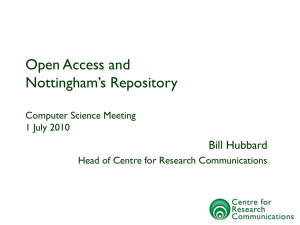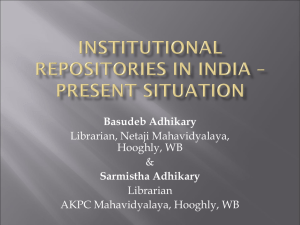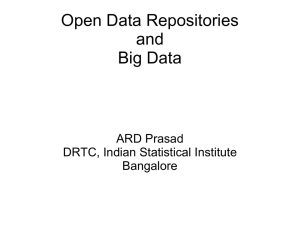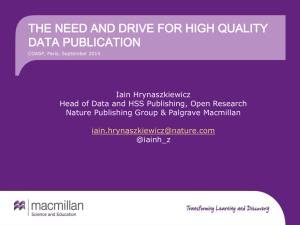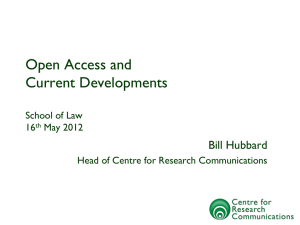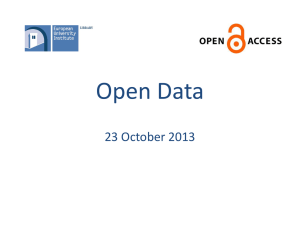recommended practices to enable access to manuscript and
advertisement
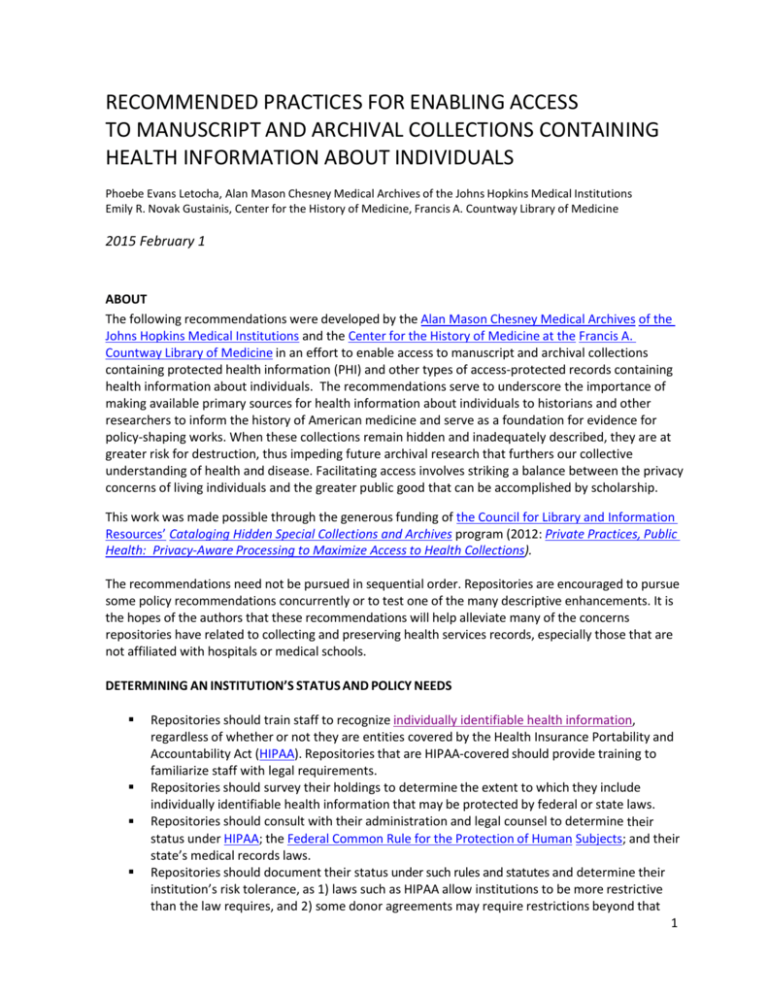
RECOMMENDED PRACTICES FOR ENABLING ACCESS TO MANUSCRIPT AND ARCHIVAL COLLECTIONS CONTAINING HEALTH INFORMATION ABOUT INDIVIDUALS Phoebe Evans Letocha, Alan Mason Chesney Medical Archives of the Johns Hopkins Medical Institutions Emily R. Novak Gustainis, Center for the History of Medicine, Francis A. Countway Library of Medicine 2015 February 1 ABOUT The following recommendations were developed by the Alan Mason Chesney Medical Archives of the Johns Hopkins Medical Institutions and the Center for the History of Medicine at the Francis A. Countway Library of Medicine in an effort to enable access to manuscript and archival collections containing protected health information (PHI) and other types of access-protected records containing health information about individuals. The recommendations serve to underscore the importance of making available primary sources for health information about individuals to historians and other researchers to inform the history of American medicine and serve as a foundation for evidence for policy-shaping works. When these collections remain hidden and inadequately described, they are at greater risk for destruction, thus impeding future archival research that furthers our collective understanding of health and disease. Facilitating access involves striking a balance between the privacy concerns of living individuals and the greater public good that can be accomplished by scholarship. This work was made possible through the generous funding of the Council for Library and Information Resources’ Cataloging Hidden Special Collections and Archives program (2012: Private Practices, Public Health: Privacy-Aware Processing to Maximize Access to Health Collections). The recommendations need not be pursued in sequential order. Repositories are encouraged to pursue some policy recommendations concurrently or to test one of the many descriptive enhancements. It is the hopes of the authors that these recommendations will help alleviate many of the concerns repositories have related to collecting and preserving health services records, especially those that are not affiliated with hospitals or medical schools. DETERMINING AN INSTITUTION’S STATUS AND POLICY NEEDS Repositories should train staff to recognize individually identifiable health information, regardless of whether or not they are entities covered by the Health Insurance Portability and Accountability Act (HIPAA). Repositories that are HIPAA-covered should provide training to familiarize staff with legal requirements. Repositories should survey their holdings to determine the extent to which they include individually identifiable health information that may be protected by federal or state laws. Repositories should consult with their administration and legal counsel to determine their status under HIPAA; the Federal Common Rule for the Protection of Human Subjects; and their state’s medical records laws. Repositories should document their status under such rules and statutes and determine their institution’s risk tolerance, as 1) laws such as HIPAA allow institutions to be more restrictive than the law requires, and 2) some donor agreements may require restrictions beyond that 1 which is covered by HIPAA. Repositories should create intra-organizational partnerships to align policies, for example, among special collections repositories at the same institution, medical records/health information management departments in hospitals, and/or institutional records management offices. Repositories holding records of outside institutions that contain individually identifiable health information should consult with the depositing institution and with their own legal counsel to determine whether housing the records would make the repository subject to HIPAA business associate agreements. Repositories should review the types of requests that they receive for access to individually identifiable health information and develop access review processes relevant to the type of use requested, such as medical genealogy, biography, and research as defined by HIPAA and the Common Rule. IMPLEMENTING POLICY AND FOSTERING PROCESS TRANSPARENCY Repositories, to the extent possible, may want to create an impartial Access Board or Privacy Board or consult with an Institutional Review Board (IRB) to review applications for access to protected health information and medical records in their holdings. An archivist with knowledge of the holdings should be designated to be part of the review process, either as an advisor to or as a member of the review board. If no Access Board is possible, repositories should be prepared to explain why access can be granted to some users and not others. Repositories should document their decision-making processes and policies and apply them consistently. Decision trees may be helpful tools to review access decisions (see Johns Hopkins examples). Repositories should publish their access and use policies on their websites and should provide copies of any application forms online; researchers should be reminded that publishers may also have their own privacy requirements as a condition of accepting a manuscript for publication. Repositories should clearly articulate the steps a researcher or other user would need to take to apply for access and the application workflow, so that users know how far in advance they will need to make an application before they may be granted access. Repositories may wish to provide model applications or a process by which applicants can ask questions or seek guidance on the application process so that they can successfully complete the application. Repositories should create a user agreement for patrons to sign that communicates personal liability for the misuse or distribution of health information about individuals. COMMUNICATING THE NATURE OF RESTRICTIONS Repositories should provide non-technical information on their websites about the kinds of access restrictions their users will encounter when considering the use of records, regardless of whether restrictions are imposed by: Federal law (HIPAA, FERPA); United States government records laws; state law; gift agreement; deposit agreement; or institutional policy. Repositories should provide at least one example of each of the restrictions found in their collections using a published or otherwise publicly available finding aid or catalog record to illustrate the restrictions. Repositories should explain where users can find information about access restrictions, such 2 as publicly accessible catalog records, online finding aids, or published inventories. Repositories should provide information about the gaps in systems where information is generally provided (such as restrictions only being noted in catalog records for collections that have been processed), as well as overtly state when information about access restrictions is only available through consultation with Public Services staff. Repositories should embed information regarding the presence of access restrictions at all levels of hierarchical description. Collection-level access descriptions may alert users to the presence of restrictions, but it is series, subseries, and folder-level notices regarding access status that enable users to understand which restrictions apply to records of interest. Repositories should clearly articulate their policies regarding citation. Access Board and IRB applications should clearly indicate if citation is permitted, and if so, repositories should have specific examples for citing records in collections that are not accessible without access approval and, if the collection is unprocessed, whose physical organization may change in the future. Repositories may want to allow and encourage users to deposit a code key to medical records and other protected records that cannot be cited by identifiers, such as patient name or medical record number, without authorization. Repositories should clearly state in finding aids when records have been redacted or removed from the collection. DESCRIBING RECORDS TO BEST ENABLE DISCOVERY AND ACCESS The following recommendations are intended to illustrate the rich descriptive information that archivists can offer without revealing patient names or other identifiers. When selecting descriptive approaches, processors should balance the needs of their research communities with local processing practices to determine which of the following descriptive enhancements could improve discoverability and use of their collections. When describing collections containing health information, communicate the specific record formats in which health information is found. A developing list of different kinds of records containing health information and their scope may be found here. Examples include: admission records; autopsy records; case files; diagnostic indices; doctor-patient correspondence; medical records; patient histories; prescription logs; surgical logbooks; and specimens. If you are not sure of the kind of record you have, try to create a redacted copy of the record (or a page or two from a volume) and consult an archivist or librarian who more routinely encounters these types of records. Descriptions should overtly state if a collection is a part of a much larger, original group of records, as well as inform users as to what happened to the rest of the records or where they may be found. (For example, when a collection consists of twenty boxes transferred to the archives as a representative sample from an original 100 boxes of records, indicate that the remaining eighty boxes were destroyed per institutional policy.) Specimens related to a collection that are housed elsewhere should be indicated, regardless of whether or not they can be accessed. Processors should identify when records were created for a specific research study or when doctors assembled sets of patient records as source material for specific publications. Processors should record types of commonly collected information about patients in the records, such as diagnoses, names, dates of birth/death, and ages at time of treatment. As time or expertise permits, processors should sample the records and incorporate in to the description patient-related information, such as marital status, number of children, race, ethnicity, occupation, and place of residence or employment; and treatment-related 3 information, such as the names of frequently mentioned doctors, surgeons, midwives, mental health professionals, and/or dentists encountered, the names of pharmaceuticals, types of medical treatments and procedures, and instrumentation and devices used. A developing list of variables may be found here. Because processing methodologies vary from repository to repository, processing information in finding aids should include how record descriptions were created, such as through a percentage of records sampled per container or per alphabetical or numeric run. Repositories should enable opportunities for user enhancement of collection descriptions, particularly for unprocessed or infrequently used collections. A survey instrument or quick conversation with a researcher may help contextualize records, add to lists of procedures or treatments employed, or enrich collection-level descriptions of holdings. Users may also provide examples of “the patient’s own words” that can be included anonymously in finding aids to help characterize records. Similarly, health care providers familiar with the creation of specific categories of patient record types can help contextualize records based on their clinical experience of how records are used. Health care providers may also be able to decipher medical shorthand or abbreviation unfamiliar to archivists who don’t have specialized medical training or familiarity with local institutional terms. Repositories should consider digitally imaging redacted versions of records and embedding them in finding aids in order to visually communicate how information is organized in the records. Repositories can also consider embedding blank versions of survey instruments, commonly found forms in medical records, pages from codebooks, and protocols. 4


